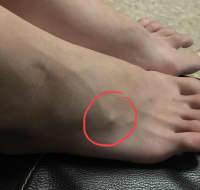Bone spurs are a fairly common occurrence on the foot and frequently occur either at the plantar area (base of foot) or the Achilles region (heel area).
Treatment of bone spurs on the foot depends on the severity of symptoms that my patient shares with me.
1- Asymptomatic bone spurs on foot, picked up incidentally on XRays, require no treatment. I will just advise my patient on proper footcare and footwear to reduce the risk of the bone spur from worsening.
2- Mild, occasional pain
- Proper footwear with proper insoles for shoes to relieve pressure from the bone spur
- I may recommend my patient to see a podiatrist (foot doctor) for customised insoles for their shoes.
- Regular stretching of the foot
- Painkillers when necessary to reduce the inflammation and pain
3- Ongoing, “niggling” pain affecting patient’s daily life
I will recommend a trial of an H&L injection, which is essentially an injection consisting of steroid into the painful area. A lot of my patients shudder at the mention of injection of steroids as they often associate it with multiple side effects.
Oral steroids taken long term have the potential to cause side effects to the body. Whereas an H&L injection is a localised form of treatment and the potential side effects generally happen at the site of injection. It includes bleeding, bruising, infection and tendon rupture.
What an H&L injection does essentially, is to reduce the inflammation of the soft tissue which is the main cause of pain.
However, I will take extra care to explain to my patient on the potential of recurrence. In the event of frequent recurrences, H&L injection is not a long term solution as repeated injections increase the risk of tendon rupture which will require surgery to repair it
4- Recurrent pain despite treatment : As mentioned previously, recurrent pain despite the previous measures I shared, will require a referral to my orthopaedics colleagues for a review and possible surgery to “shave” off the bony spur.




